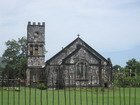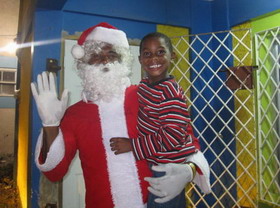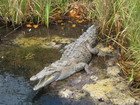Jamaican Money
Want to know how much Jamaican Money your dollar is worth? Well, up to the late 1960's, the Jamaican dollar was worth more than the US dollar.
That's a very distant memory, sorry to say. Our once proud Jamaican currencyhas been so bruised and battered that some of our coins are regarded as a nuisance and actually thrown in the garbage!
Here is the frontal view of the notes which are currently in use.
The $50 bill: The fifty dollar bill bears the image of Samuel Sharpe, one of Jamaica's National Heroes.
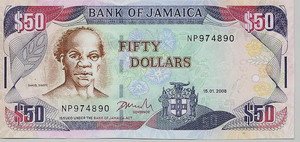
The $100 bill: The one hundred dollar bill features Donald Sangster, the second (and shortest serving) Prime Minister of Jamaica. This note is widely referred to as a "bills".
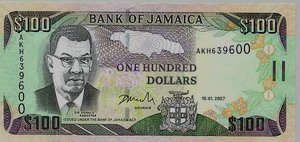
The $500 bill: The five hundred dollar bill features Nanny of the Maroons, Jamaica's only National Heroine. The note is commonly known as a "nanny".
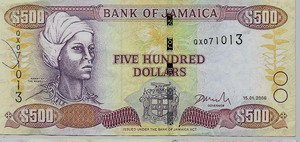
The $1000 bill: Michael Manley, Jamaica's fourth and sixth Prime Minister is the face on the one thousand dollar bill. As in some other countries, it is also called a "grand".
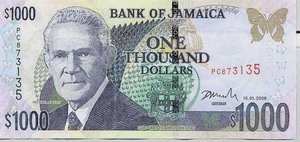
The $5000 bill: This is the most recently issued Jamaican note, and bears the image of Hugh Lawson Shearer, Jamaica's 3rd Prime Minister.
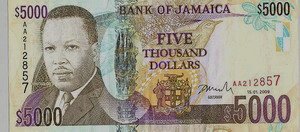
The Jamaican Coat of Arms appears on all Jamaican money, on the front of notes and on the back of coins.
Our coins come in the following denominations: $20, $10, $5, $1, 25c, 10c, 5c, and all bear the face of a National Hero.
Many smaller businesses, especially in rural areas, will not accept or issue coins under a dollar in value (red money). Most children don't even want them in their piggy banks, and even beggars find them of little use!
When shopping, don't expect to get back exact change for fractions of a dollar. Bills are usually rounded up to the nearest dollar - they are rarely ever rounded down in favour of the customer.
History of Jamaican money
Coins from many different countries were widely used in Jamaica between the 17th and the 19th centuries, as early Jamaican history unfolded. The colonial government set exchange values for these coins in terms of British pounds, shillings and pence.
The first Jamaican coins were made in 1869 - the penny and the half penny. In the 19th century, private banks began issuing banknotes, and continued to do so until 1940. At this time the government's appointed agent assumed responsibility for issuing all paper money in Jamaica.
I can remember my grandmother (who was born in 1895) using what were the slang words of her time to describe the different denominations of Jamaican money. Words like gill, thruppance, penny ha-penny, quattie, farthing. As a child, it seemed to me that only mysterious things could have been bought with money that had such mysterious names!
When the Bank of Jamaica was established in 1960, it became responsible for issuing all Jamaican currency, which at that time was still denominated in pounds, shillings and pence.
In 1969, the sterling system was replaced by the decimal system of dollars and cents, and the old time names became a thing of the past.
I hope this page on Jamaican money has been useful, and informative. If you find that you have excessive amounts of the stuff, do bear me in mind!
Return from Jamaican Money to Real Jamaica Vacations





